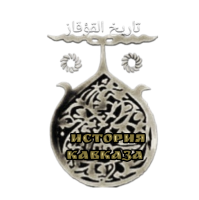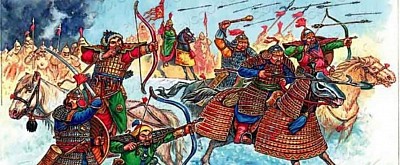Khanates after the collapse of the Golden Horde
The Golden Horde stretched so that it took eight months to travel from east to west through the Horde, and five months from north to south.
In the west, Ulus Jochi included Moldavia and the Crimea , in the south it reached Khorezm, and in the north, the northeastern principalities of Rus were subordinate to the Golden Horde.
The Golden Horde had two capitals: Sarai-Batu was located to the west of the r. Volga, the city of Sygnak was located in the southeast of the Syr-Darya River .
The collapse of the Horde began in the second half of the XIV century, during the invasion of Tamerlane.
The last khan of the Golden Horde, Kichi Muhammad, died in 1459, after which Russia heaved a sigh of relief. The Great Horde appeared instead of the Golden Horde.
After the death of Kichi-Muhammad, the Big Horde was led by his ardent opponent Khan Akhmat, who in 1480 undertook
a desperate attempt to return the Horde to its former greatness and force the sovereign of all Russia Ivan III to pay tribute to him, but the attempt failed.
A year later, the khan died during an attack on his headquarters by the enemy cavalry, among which were the soldiers of another successor to the Golden Horde - the Siberian Khanate.
The Siberian Khanate is a Turkic state that arose around 1568 in Western Siberia and existed for 130 years.
It stretched from the Permian lands to the mouth of the Ob in the north, bordered in the east with the Pied Horde (the Selkup and Ket tribes), and in the south it was adjacent to the Nogais and Teleuts .
The state structure of the multinational khanate was of a paramilitary character. The khan was chosen by the top of the nobility - the murzas, beks and tarhans . The beks themselves ruled over their lands, but were obliged to participate in wars, allocating warriors and horses to the khan. The non-Turkic population: Ostyaks, Samoyeds and Mansi, was in complete subordination. The most famous of the Siberian khans was Khan Kuchum , who subjugated not only the Khanty and Mansi , but even the Baraba steppes and some Bashkir tribes , forcing everyone to pay yasak .
The pride of the Khanate was the army, numbering 10,000 soldiers , which had its own artillery. Considering that at that time the army usually accounted for one fifth of the total population, it can be assumed that the population of the khanate was small - about 50-60,000 people.
Another successor to the Horde was the Kazan Khanate, the founder of which is considered to be Khan Ulu-Muhammad - the enemy of the Golden Horde Khan Kichi-Muhammad.
After a clash with Kichi, he migrated beyond the Volga, expelled the local khan, and seizing Kazan , built a new capital nearby. The heyday of the khanate came in the second half of the 15th century - it reached 700,000 square meters. kilometers, and on its territory lived Tatars , Votyaks , Chuvashs , Cheremis , Bashkirs , Meshchera and Mordovians .
In 1552, the khanate was conquered by Ivan the Terrible and annexed to the Russian kingdom .
The fourth successor to the Golden Horde was the Kazakh Khanate, which was formed on the lands of the Horde and the Uzbek Khanate . It went through a tumultuous history of falls and rebirths, civil war, disintegration into separate Zhuzes and a new unification into a khanate, and existed until the middle of the 19th century, until it became part of the Turkestan General Government of the Russian Empire.
The khanate reached its highest prosperity during the reign of Khan Kasym , conducting diplomatic relations with Russia and the Crimea , but the main interests of the khanate were directed to the neighboring Central Asian states.
The Astrakhan Khanate turned out to be the smallest fragment of the Golden Horde and was located at the mouth of the Volga ; Tatars and Nogai became its inhabitants. The Khanate ceased to exist on June 29, 1554 , when its army was defeated by the Russian army, headed by Prince Pronsky , who was sent to establish the dominion of the Russian kingdom along the entire Volga.
The Astrakhan Khanate was a buffer between the Crimean Khanate and the Nogai Horde - the most powerful successor to the Jochi ulus .
The Nogai Horde turned out to be not only the largest state left after the Horde, but also caused the Russians a lot of trouble.
The Nogai horde was led by Muslim Mangyts , who came from Mongolia .
At the origins of the Horde was Khan Edigei , who defeated the Lithuanian Vitovt and forced Vasily I to resume paying tribute to the Tatars . The population of the horde reached 1,000,000 people, and the army numbered up to 200,000 soldiers.
By the 17th century, the horde split into several small khanates, and the Nogai settled in the North Caucasus and the Black Sea region , and some joined the Crimean Khanate and even the Ottoman Empire .
The Crimean Khanate lasted longer than the others thanks to the patronage of the Ottoman Empire and became part of Russia only 1783 .
For a long time, a brisk trade in Slavic slaves went through the Crimean Khanate, who were sold to the east. Despite the small territory, by the end of the state's existence, about 3,000,000 people lived on its territory.
The founder of the Kasimov Khanate was Ulug Mohammed Kasim . The capital of the khanate was the city of Kasimov. Tatars, Mordovians and Tatars-Mishars lived in the Kasimov Khanate. The Muslim state was headed by a khan with Karachais, and the nobility were beks or murzas . The population consisted of merchants, artisans and peasants. Even in the 16th century, a slave market operated in Kasimov, where people of different nationalities were sold.


